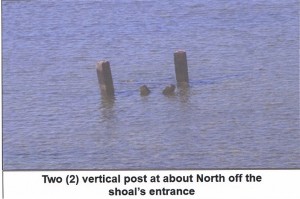
THE concrete blocks in Bajo de Masinloc, which Philippine defense and military officials last month accused China of putting there, may have actually been placed by the United States Navy decades ago, military sources said.
A military investigation found that the concrete slabs were covered by algae, an indication that they had been in the area for many years. The probe also found that the blocks had been used by the U.S. Navy as “sinkers” to preserve the wreckage of old ships they used for target practice.
The information contradicts Defense Secretary Voltaire Gazmin’s statement at the congressional budget hearing in September in which he accused China of laying the foundation for structures similar to what it did in Mischief Reef in the Spratly Islands in 1995.
Gazmin released photos of some 75 concrete blocks scattered within Bajo de Masinloc, including a photo of two vertical posts at the shoal’s entrance. Philippine Navy Chief Jose Luis Alano had said they would remove the concrete blocks while Foreign Secretary Alberto del Rosario said the government would file a diplomatic protest with China. The blocks were never removed; the protest was never filed.
Bajo de Masinloc, known internationally as Scarborough Shoal, is 124 nautical miles off Zambales, which was home to the Subic Naval Base for more than 80 years. Subic was a major ship repair, supply, and rest and recreation facility of the United States Navy until 1991 when the Philippine Senate junked the RP-US Military Bases Agreement.
China claims the shoal, 467 nautical miles away from the mainland, as part of its territory with the name Huangyan Island.

Bajo de Masinloc is referred to as Panatag (calm in Tagalog) by Filipino fishermen who seek refuge in the area during stormy weather.
Sources said the U.S. Navy used Bajo de Masinloc as an impact or bombing range. The concrete slabs were needed as “sinkers” to keep the balance of the old decrepit ships which were placed in the shoal for the U.S. Navy’s shooting and bombing runs.
Over the years, however, the derelicts became the subject of “salvage operations by local salvors also known as kumbatseros.”
VERA Files sought a statement from the U.S. Embassy but was referred to Gazmin’s office “for any clarification of his remarks.” VERA Files also asked for a statement from Gazmin’s office but did not get any response.
Military sources also said they interviewed a number of fishermen who had seen the concrete blocks way back in the late 1980s and even used them as step boards during high tide.
President Aquino, speaking at the annual presidential forum of the Foreign Correspondents Association of the Philippines, shared the information that the concrete blocks “are very, very old concrete blocks. Some of them have barnacles attach to them. They are not a new phenomenon.”
Following Gazmin’s statement before Congress, China accused the Philippines of fabricating the photos, and released its own photos of Bajo de Masinloc without the concrete blocks.
The two vertical posts north of the shoal’s entrance turned out to be part of structures placed by the Philippine Navy in 1989, as part of the aborted plan to build a lighthouse there.
Aquino said he does not see any immediate need to remove the concrete blocks, which do not “present immediate danger to any of our vessels or even those that would transit in the area around Scarborough shoal.”
Despite the almost permanent presence of three Chinese ships in Bajo de Masinloc since April 2012, Aquino insists the Philippines has not lost the 120-square-kilometer strategically vital shoal because “we can still go there and we do have overflight missions,” adding that Filipino fishermen “are still in that area.”
The three-month standoff between the Philippines and China in Bajo de Masinloc last year triggered the filing by the Philippines of a suit before the United Nations Arbitral Tribunal. The Philippine government has questioned the legality of China’s 9-dash line that encompasses almost the whole of the South China Sea and encroaches on the exclusive economic zone of several countries in the Southeast Asia.
China has refused to participate in the U.N. suit.





